Depends on how well the painting is done wooden house outside, depends appearance and the service life of the material, and the interior decoration should provide comfort and coziness in the room.
The following factors negatively affect the tree:
- sun rays;
- temperature changes;
- wind, frost;
- dust, debris;
- bacteria and insects;
- time.
How to paint
Before you paint wooden house outside, you need to choose the right paint for coating. It is usually divided into three categories:
- Antiseptics. This material penetrates deep into the wood (up to 7 mm) and protects both the surface and the inside of the wood from rot, mold and other factors. Antiseptics can be glazing (transparent) and covering. The difference lies only in appearance - transparent antiseptics preserve the appearance of the wood as much as possible. The covering ones completely hide the texture. Typically, antiseptics last for about 5 years.
- Acrylic paints. An environmentally friendly material based on acrylates and water, which protects wood well from moisture and low temperatures. In addition, acrylic paints do not have strong odors and allow wood to “breathe”. Such paints have the longest service life - up to 10 years.
- Oil paints. Made on the basis of drying oil, which allows the material to penetrate deeply into the structure of the wood and provides it reliable protection. This paint is cheap, but has a number of disadvantages - a strong smell, takes a long time to dry, and changes color over time. Typically, oil paints need to be changed every 4-6 years.
Which material to choose? It all depends on your conditions, goals, means. It is best not to skimp on finishing - wood requires high-quality finishing. Professionals advise using more expensive, natural paints. As for color, only your preferences play a role here.
How to paint correctly
Painting the outside of a wooden building is not a difficult task, but quite voluminous. Let's divide the process into three stages:
- Surface preparation.
- Painting.
Surface preparation
If the house has already been painted before, then, first of all, you need to completely clean the walls of the old paint. It is better to do this using special removers that do not damage the structure of the wood. Old paint can also be cleaned using a regular brush. A hair dryer also copes well with this task - the paint easily peels off the wall.
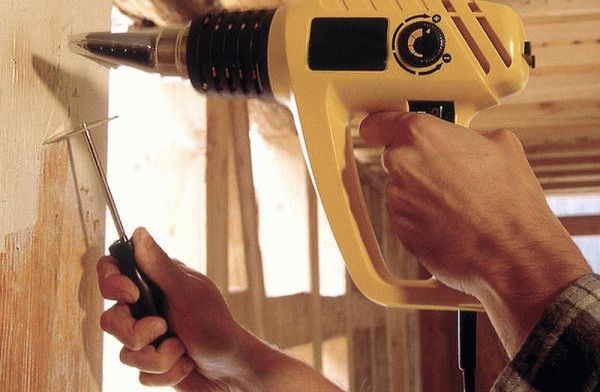
After cleaning the walls, you need to wash them and let them dry. At this time, you can inspect problem areas - replace rotten boards, seal cracks, treat mold and blue stains with special means.
If the house is new, then simply skip the process of removing old paint.
Applying primer
Once all the previous steps have been completed, you can begin applying the primer. It is applied in two layers - here it is important to guess the moment when the first layer is no longer damp, but has not completely dried. It is best to apply a second coat at this time.
Primer antiseptic is extremely important to protect the wood, if you decide to skip this step, then it is quite possible that you will regret it in the near future. You should not skimp on primer - otherwise the tree will not last too long.
Painting
When the primer has dried, you can proceed directly to painting the wood. It's better to wait for a warm, but not too hot day. The fact is that in the heat the paint dries too quickly, not penetrating deep enough into the wood.
Which tool is better to use? It is selected depending on the consistency of the cladding and the texture of the wood:
- a smooth wall is painted with a short-haired roller or brush, a textured wall with a long-bristled brush;
- textured paints are applied using a spatula.
As for the spray gun, it is used only by highly qualified specialists.
When the paint is completely dry, you can begin applying the second coat.
Painting wood inside the house
![]()
The purposes for painting walls can be varied, but most often wood is painted indoors for the following reasons:
- to extend the service life of the material;
- for security purposes;
- for decorative purposes.
How to paint the inside of a house
For interior finishing, the same types of paint are used as for exterior finishing. The difference is that most of them are water-based, which reduces toxicity and allows you to work in enclosed spaces. In addition, fire retardants are added to this list. Fire retardants are compounds that are used to treat wood to prevent fires in the house. However, it is better if the wood was coated with fire retardant at the factory - in this case the coating works better.
Most often, for interior decoration use transparent and translucent varnishes and impregnations. In this case, you will preserve the beauty of the tree to the greatest extent. If it’s time to hide any flaws, you will have to use decorative coatings - acrylic and oil paints. Oil paints are used more often due to their low cost. However, such paint has a pungent, persistent odor, which limits the possibilities of its use in the cold season, when ventilating the room is problematic.
Using antiseptics and paints for interior works, make sure they can be used indoors. This is usually indicated on the label.
How to paint correctly
Painting a wooden house inside is not much different from painting it outside. Basically, all the same preparation and processing processes, with the exception of some nuances.
Stages of work when painting the interior of a house:
- Preparation.
- Antiseptic treatment.
- Fire retardant treatment.
- Painting.
Preparation
Again, if the walls were previously painted, you need to clean them of old paint. Just cleaning interior walls with a wire brush, try not to apply too much force, as this may damage the wood. If this does happen, sand the top layer using a sanding machine or sandpaper.
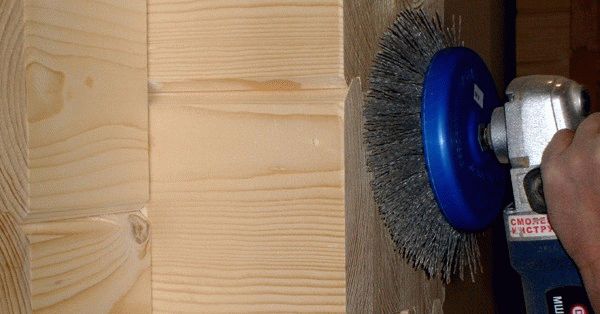
After this (or if the walls have not yet been painted), treat the wood with water.
Antiseptic and fire retardant treatment
When the walls are dry, you can start treating them with an antiseptic. Please note that some areas (sockets, etc.) must be covered with plastic bags and tape.
Painting
When all the previous steps have been completed and the fire retardant has dried, you can begin painting the wood. Each type of paint is applied differently - check with the seller for this information. In general, experts recommend applying several thin layers instead of one thick one. For painting, it is best to use a sprayer, but if you decide to use a brush, then you need to paint along the panel, without lifting it from the surface.
Safety precautions
When working with paint, wear appropriate skin, eye and respiratory protection. Strictly follow safety precautions - use goggles, respirators, regularly ventilate the room and go out into the fresh air.
Sooner or later, every owner own home The question arises, how to paint the outside of a wooden house? Even if it is built from expensive materials that have undergone high-quality professional processing, the façade of the building must be updated over time. In addition, in this way you can save on the cost of materials, while ensuring that the work is done well.
If you use untreated wood, you can save a lot on costs.
Why does wood age?
Despite all the advantages of natural wood, its main disadvantage is that it is a living natural material. Like other living matter, wood also ages over time, especially when cut down, this happens much faster. Paint can protect wood from rot, mold or blue stains.
How to paint the outside of an old wooden house
The choice of material for painting the house depends on the condition of the walls, as well as the paint previously applied to the façade of the structure. It may be that high-quality repairs Only needed for one wall. The rest will only need a light update using the same paint.
- “Oil paint works best over previous coatings. But no other coating can be applied to it. That is, you will have to use either the same type of paint each time, or completely remove the previous layers.”
First, you need to clean the surface of old paint using brushes or scrapers or using special chemical agents in order to preserve the structure of the wood and not scratch it. After cleaning the surface, the wood must be thoroughly rinsed and left to dry. If there are areas covered with blue or mold, they must be treated with special chemical agents.
“To ensure the best possible adhesion of paint to wood, a special alkaline solution is applied to the surface before applying the paint.”
If the boards are severely rotten or damaged, they should be replaced. The process of painting the facade of an old wooden house is identical to the classic one.
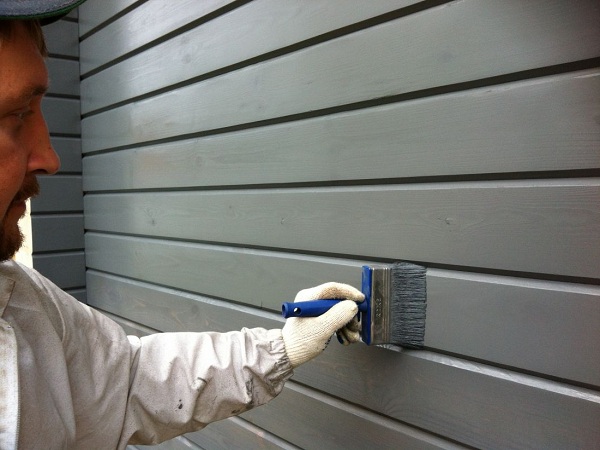
What paint is best to paint the outside of a wooden house?
Before deciding how to paint the outside of a wooden house, it is worth familiarizing yourself with the main types of materials. There are three types of coating for wooden houses:
· Antiseptic. This material penetrates deeply into the wood structure (up to 7 mm), thereby preventing the formation of rot, mold and blue stains, as well as protecting the wood from negative influences external factors (environment). In turn, antiseptics are divided into two main subtypes:
- 1. Glazing - the transparent structure of the product penetrates deep into the structure of the wood, preserving its natural structure and color, and also adds a noble shine.
- 2. Covering – the structure of which is opaque. They will completely hide the wood structure. However, its relief and structure will remain distinguishable.
· Paint is an antiseptic that helps protect the house from mold and protects the wood from negative external factors. Paints also come in different types:
- 1. Acrylic. When choosing the best way to paint the facade of a wooden house, it is important to consider that this type of paint is the most in demand. The material is environmentally friendly because it is based on water and acrylates, which act as binding elements. Acrylic paint protects the tree from moisture. At the same time, it retains its breathable properties, due to which normal air circulation occurs in the wood. Also, the coating is quite wear-resistant, behaves against aggressive external influences and mechanical damage, and is resistant to low temperatures. The paint does not smell unpleasant, which is beneficial when carrying out painting work. Due to the fact that the polymer emulsion does not react with oxygen, the gloss remains as desired and is not lost at all!
- 2. Oil paint is very well absorbed into the wood structure, creating a kind of barrier that protects the wood from the negative influences of the external environment. Accordingly, the penetration of moisture into the wood is blocked. Today this type of paint is less relevant. Firstly, this is due to the fact that the paint takes a very long time to dry (up to 24 hours). Because of this, it is important to know the weather forecast so that after painting the facade of the house there is no rain, because it will destroy some of the properties of the material. Secondly, after some time, the paint changes its tone, in which yellowness appears.
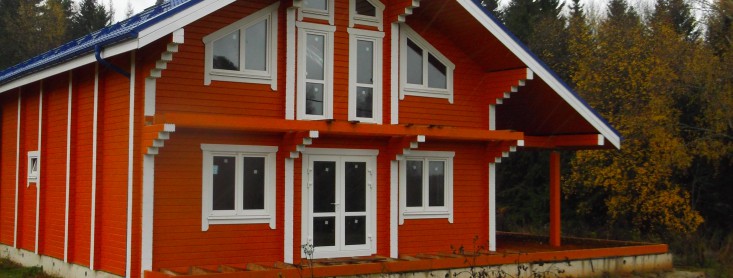
When choosing what paint to paint the outside of a wooden house, you should take into account the durability of the material so that painting the facade does not have to be done too often.
In addition, if we take into account the service life of the painting materials and when choosing the best way to expose the surface of the house, it is worth considering this factor for each type of material:
- · Glazing coatings will last 3-5 years
- · 5-7 – covering. After this period they will need to be updated.
- · 4-6 – oil.
- · 7-10 – acrylic.
As for the choice color range materials for opening the wooden facade of a building, each owner chooses from his own wishes and preferences.
It is also important to take into account the fact that if the house is located near a body of water, its facade must be additionally protected with high-quality resistant materials.
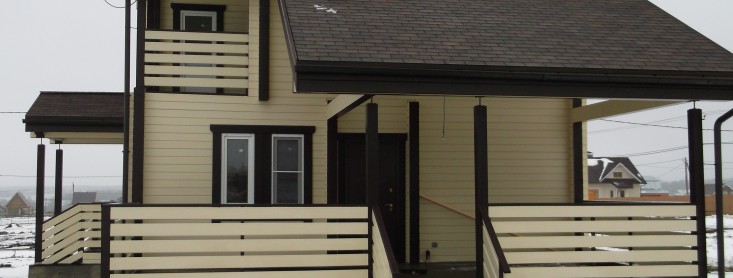
How to paint a wooden house correctly
The process of painting a house made of natural wood consists of the following main stages:
- · Preparatory work on the façade surface, thereby improving adhesion properties and, therefore, ensuring a durable coating.
- · To prevent various diseases wood and saving on painting the facade, a primer is applied - an antiseptic.
- · The surface is painted.
Depending on whether the wood has been previously painted, the work performed may vary significantly.
How to beautifully paint a wooden house if it is new?
Only well-dried wooden beams need to be coated with paint. If they are wet, you need to apply an antiseptic primer to them and wait until the surface dries well. The walls must first be very well cleaned of dirt and accumulated dust. The best way to do this is with water and a stiff brush. If resin appears on the beams, it must be removed with an iron brush, and then the area must be treated with a special varnish for knots. If there is a suspicion of mold or blue staining, you should immediately treat it with special means. After spending preparatory work, the wood “rests” for up to two weeks.
- “If the owner is concerned about the question of how to beautifully paint a wooden house, it is very important to adhere to the basic rules!”
Before painting the house, it is best to treat metal surfaces (for example, nails, staples, etc.) using an anti-corrosion primer.
It is best to carry out work on a warm, not windy and not hot day. The paint is periodically mixed during the work so that the shade of the painted surface is uniform and identical. The material must be applied in the longitudinal direction. And before applying a new layer, the previous one must dry thoroughly.
Knowing the main factors: how to paint the facade of a wooden house, as well as how to beautifully paint a wooden house - all the work will go flawlessly!
How to paint the inside of a wooden house
The interior of the house is pre-prepared, after which it is treated with antiseptics to prevent rotting, etc., after which a glazing compound (decorative paint) is applied.
Carrying out painting work inside the house is a rather labor-intensive process. But the most important thing here is to follow technology.
Each owner chooses the most suitable and acceptable material for his home. To carry out finishing works inside the house, the main types of materials offered on the market are:
- · Oil-based paints that penetrate deeply into the wood structure, thereby protecting it from fungus and mold.
- · Acrylic type is the most inexpensive and accessible option. They have a fairly wide range of colors, from which you can choose the most unusually beautiful colors for interior decoration. In addition, this paint does not stink and dries quickly. Its disadvantage is its rapid flammability, which is why it must be used together with antipyrine.
- · Water-based paint– an excellent option for interior decoration of the house. The room does not “clog”, the walls “breathe”. In case of contamination, the walls can be easily washed and, if necessary, damaged areas can be restored.
When carrying out painting work inside and outside a wooden house, it is important to treat the entire process carefully and seriously. After all, not only beauty, but also coziness and, of course, comfort will depend on how well the work is done!
Comments:
Every owner of a wooden house should periodically think about protecting its walls. Wood is subject to destruction due to seasonal temperature changes, high humidity and ultraviolet radiation. Moreover, fungi, mold or various insects may appear in it. Painting an old wooden house can help solve these problems.
Before you start painting, you need to prepare the walls: check the elements of the old cladding, seal cracks, and prime the surface.
Causes of damage to old coating
Old paint may begin to peel or bubble. Basically, this problem appears due to the increased content of condensate. The reason for its occurrence may be wear of the putty coating, blockage drainage system or poor-quality processing of seams or cracks.
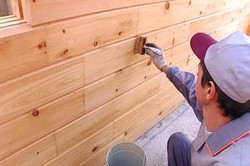
In order for the paint to adhere well to the wall, it is necessary to apply a layer of primer to the surface to be treated.
To fix this problem, you need to eliminate the source of moisture. To do this, it is necessary to thoroughly study the condition of the walls of a wooden house from the outside. Then check the condition of the roof, all existing gutters, window bays and cladding and seam joints. If cracks are found on the outside walls of a wooden house, they must be repaired (sealed). After this, you need to check the condition of the putty; if it falls off, then it needs to be renewed. The next step before painting the exterior of a wooden house is to apply a primer, otherwise the wood may absorb the solvent, which will lead to poor performance.
Peeling of paint can also occur under the eaves, where weather exposure is minimal. This happens mainly in plates that have a small thickness. In this case, moisture interacts with chemical composition paint, which leads to the appearance of salt deposits. The resulting salts will accumulate water, which will freeze when low temperatures arrive. When frozen, water is subject to expansion, so it will lift the top layers of paint, causing it to delaminate.
To avoid this, you need to wash the surface of the wall located under the eaves using regular detergents. You can also use a car wash for these purposes, which will allow you to wash under pressure. After this, the paint that will peel off must be removed from the surface of the walls.
Crack Treatment
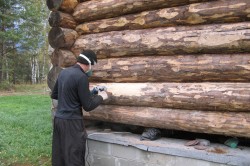
To avoid delamination of previously painted layers, and to avoid the appearance of unevenness on the walls, you need to grind the base to the surface of the log.
From time to time, cases arise when the paint on the outside of a wooden house is accompanied by cracking of the base of the walls. Small fractures may appear at first, which can eventually form larger cracks. Such defects contribute to the penetration of dampness under the surface of the coating and, as a result, the destruction of the paint of a wooden house.
Moreover, dampness that gets into the cracks will lead to mold and various fungi getting onto the surface of the wall. This will not only lead to damage to the material in the future, but may also cause various types diseases, including pulmonary ones.
The walls of some houses may have been painted more than once, so the lower layers of the coating have become completely fragile, which leads to delamination of all layers in turn. As a result, water can get on the wood and it will swell, which will lead to the appearance of cracks or an increase in the size of old ones.
To avoid such problems, you need to remove the damaged surface, after which they are polished. But most the best option there will be a complete removal of all layers of paint and varnish material, right to the surface of the log. This will prevent similar problems in the future and eliminate the appearance of unevenness on the walls.
House painting process
If the old coat of paint is faded, has a pale appearance, is moldy, or has other imperfections, it's time to start painting it. The technology for painting an old wooden house is divided into three main stages:
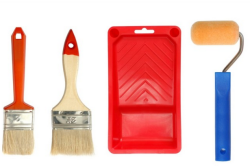
Tools for applying paint: paint brush or roller, paint container, rag or rags.
- Removing the old coating surface.
- Treating walls using primer and various antiseptics.
- Applying a coat of paint.
After the wall surface is cleaned of old paint and other coatings, you need to apply an antiseptic primer to it. After this, you need to apply paint, and for this you will need the following tools and materials:
- Paint brush or roller.
- Bucket.
- Rag or rags.
In order to paint a house with your own hands with high quality, you need to mix the paint very carefully and well to avoid applying an uneven layer of coating.
Before starting work, you can paint a small test area to understand the correct selection of the required color. The highest quality can be achieved using a brush. Its use will allow you to obtain a uniform color and thickness of the applied layer.
If possible, use a primer whose color is identical to the color of the paint. This can be done using the tinting procedure. Tinting the soil will allow you to avoid unpainted areas.
Painting the outside of a wooden house should not be done in direct sunlight to avoid the paint drying very quickly. Therefore, it is not recommended to perform such robots during the day in hot weather. Work should be avoided during precipitation (rain, snow, etc.), which will complicate the drying process of the material. The most favorable weather will be a warm, windless and partly cloudy day.
Antiseptic paint should be applied along the material to ensure better penetration into the wood fibers. Special attention need to be given to the ends of the boards or logs. These are the weakest points of wood, where water will most easily and very quickly be absorbed into the structure of the material. Therefore, it is necessary to apply paint and primer very carefully and in several layers to the ends.
Painting the outside of a wooden house is a necessary and responsible task. It will help not only preserve the surface of its walls, but also make it reliable, beautiful, and also emphasize the high status of the owner of the house.
What paint is best to paint the outside of a wooden house? The most popular construction and finishing material- wood and its “derivatives”.
However, in addition to its remarkable qualities, the material also has disadvantages that impose requirements on exterior decoration such buildings. The main enemies of wood are moisture and insects that wear it down. This article will tell you what paint to use and how to properly paint the outside of a wooden house.
Features of a wooden house
In modern construction, houses made of wood are often used. This is due to many positive characteristics of the material.
These include:
- The weight of such a house is almost three times less than a similar brick building, which allows you to significantly save money when constructing the foundation for a building, and build wooden houses, even if the soil is relatively soft.
- The tree breathes, has excellent oxygen permeability, it is easy to sleep in a wooden house, especially compared to concrete buildings, which have a very negative impact on the health of residents.
- Wood has excellent thermal insulation properties, which is due to its low thermal conductivity. A structure made of rounded logs, the diameter of which is 20 centimeters, is better thermally insulated than a building with walls made of brick 32 centimeters thick, lined on both sides with a 1.5 centimeter layer of plaster. And this saves money on heating the house.
- Cheaper wooden houses cost their owner from a material point of view. This is related:
- with a cheaper foundation;
- there is no need for decorative wall covering;
- relatively lower price of material - the cost of transportation and assembly of the house;
- during operation, the house will consume less energy for heating;
- wooden walls look more aesthetically pleasing inside and outside the building.
- A wooden building, if necessary, can always be dismantled, transported and installed in a new location. The lightness of such structures allows them to be transported in assembled form.
Along with the advantages, there are also disadvantages of buildings made of wood compared to the construction of buildings made of brick and concrete:
- The construction requires standing, up to three years, until it shrinks completely, but you can move into the house after about six months.
- Wood breathes, it tends not only to decrease in volume, but also to increase, which can elevate the structure. Because of this, many types of interior decoration cannot be done, such as laying tiles, without additional solutions, which means costs increase.
- Fire hazard.
Advice: To reduce this unpleasant phenomenon, all wooden parts should be treated with special compounds.
- Tree damage caused by bark beetles and wood rotting. In this case, you must initially use high-quality raw materials and reliable processing tools.
Such features wooden houses They also require a special solution to the question of what paint to paint the outside of a wooden house?
What types of paints can be used for exterior woodwork?
The difference between paint for interior and exterior work is quite large.
This is due to the fact that external walls are affected by:
- Sun.
- Wind.
- Rain.
- Snow.
- Large changes in pressure, humidity and temperature.
Tip: When choosing a paint and varnish material for the external walls of a wooden house, you should take these factors into account.
To paint a building with your own hands, you can use the paints shown in the photo.
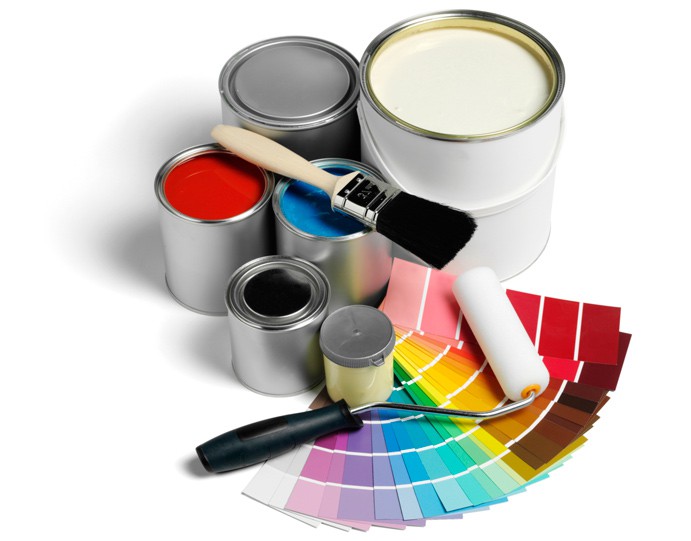
They may be:
- Oily.
The advantages of such paints include:
- based on drying oil, the product penetrates deep into the structure of the material;
- resistance to changes in atmospheric conditions.
Disadvantages of coverage are:
- the painted surface needs to be renewed every four or six years, depending on the local climate;
- it fades quite quickly, especially when applied to sunny side buildings;
- long drying time, which is several hours.
Their advantages are only in cost compared to other types of paints.
- Acrylate.
This is the best option, possessing all the necessary qualities required specifically for wood:
- they do not form an airtight layer; after coating, the log or board does not stop “breathing”;
- even after hardening, the paint has some elasticity, which protects the paint layer from cracking when the wood is deformed;
- retain their appearance for up to 8 years, which corresponds to the approximate period of cosmetic repairs for any building.
- Covering antiseptic.
The composition is based on alkyd-acrylate. This is a relatively new type of paint. With its help, even low-grade wood can be given a respectable look. This makes it possible to use cheaper materials in construction. Retains its appearance for more than 10 years.
Tip: Any paint completely hides the wood texture. Therefore, you should not paint a house made of expensive material. Painting is done when finishing a building with a simple, smoothly planed board.
For calibrated logs, laminated veneer lumber and other similar workpieces, it is better to use azures and colorless varnishes. The gloss obtained on the surface will add attractiveness to the house. Colored varnishes will not affect the wood pattern, but will only change the shade of the walls.
Some useful tips:
- When first painting a new house, the paint and varnish product is chosen at the discretion of its owner. And when recoating, it is recommended to use a product of the same composition that was used previously: “oil” is applied to oil paint, and “acrylic” is applied to acrylic paint.
- To determine the type of old paint and varnish composition, a small cut is made. If the "pattern" breaks easily, this indicates oil paint. The acrylate layer easily rolls up into a “roll”.
- If the wooden surface is exposed to sunlight, it is not worth painting. In this case, the drying of the areas will be uneven, which can lead to the formation of “stains” on the wall.
- The instructions for the paintwork must indicate the year of its manufacture.
- No paint will increase the service life of wood unless you pre-treat the wood with antiseptics, fire retardants and prime the surface.
- When choosing a specific composition, you should pay attention to its approximate consumption and resistance to ultraviolet radiation.
How to prepare the walls of your house for painting
Before painting, it is necessary to carefully prepare all surfaces of the house in order to create the desired base, this will improve the adhesion of the paint to the surface and increase the durability of the applied coating.
In this case:
- Using garden sprayer and in addition a not very hard brush, dust and other small inclusions are removed from the wood. Water absorbs dust much better than simply walking over the entire surface with a brush.
- If mold or blue discoloration is noticed on the tree, they must be removed using a special product.
- The resin, if present, is removed with a metal spatula, and the place where it was is coated with knot varnish, which will make the surface smoother.
- All metal parts, which could be the heads of nails or screws, etc., must be coated with a special primer for metal (see).
- The wood should rest for 10-14 days, covered with film. In this case, holes should be left for ventilation, and in warm weather the surfaces may not be covered.
- If the wood is damp and it is not possible to dry it, a tinted antiseptic primer should be applied directly to the damp surface and the house should be left until it dries.
How to paint a new wooden house
After deciding what paint to paint the outside of a wooden house, you can begin painting the new house.
To do this:
- Primer is applied. This antiseptic will protect the wood from fungi, mold and blue stains.
Tip: The surface primer should not be skipped. Otherwise, if you start coloring right away, you will regret it in two years, or even earlier. You cannot skimp on antiseptics; it will significantly extend the life of the new coating.
- Paint is being applied. It should be applied to a dry surface in about three layers. Each of them must dry well.
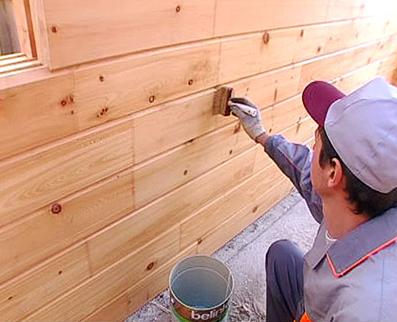
The coating is applied to a wooden surface according to the following rules:
- The paint is periodically mixed to obtain the same shade.
- It is better to apply the solution with a brush, which will ensure uniform coloring of the wood surface.
- A better quality coating can be obtained using a primer color. In this case the color will be perfect.
- Wooden surfaces should not be painted in the hot rays of the sun. In this case, the paint will dry too quickly, which is not desirable. It is best to carry out painting work in warm, cloudy and calm weather.
- Paint and antiseptic should be applied in the longitudinal direction.
- The weakest points of logs and boards are their end parts. Here the water will be absorbed very quickly. To prevent rapid destruction and the possible onset of rotting due to high humidity, the ends must be carefully treated in several layers of soil and covering material.
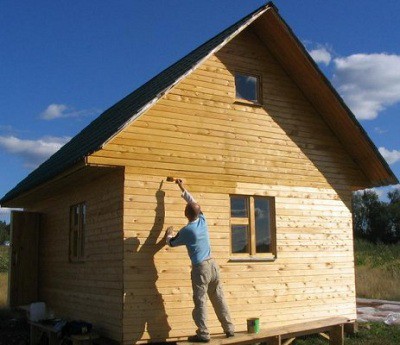
- Each element is painted sequentially from top to bottom, avoiding smudges and overlaps.
How to paint an old wooden house
Before you decide what paint to paint the outside of an old wooden house, you can watch the video in this article.
Tip: If the house is not new, and there are traces of mold, peeling paint and other defects on its facade, you should update the color with fresh paint, which will improve the appearance of the building and allow the owner to experiment with color.
Before painting, you need to carefully inspect the surface of the house:
- Maybe something has fallen off and requires immediate repair.
- The western and southern parts of the house lose their attractive appearance most quickly; these sides suffer the most negative impacts from natural phenomena.
In this case, you can limit yourself to painting only the areas that are most worn out, or completely repaint the entire building and change its color.
When repainting, you must adhere to the following rules:
- Use the same paint.
- Use the same type of coating that was used last time.
If, after purchasing a house, it is not known what kind of paint was used, you can independently try to visually determine its type:
- Acrylate paint feels and looks like thin leather. It cracks in the direction of the fibers.
- Oil paint acquires a matte appearance over time and leaves a light chalky mark on the skin when touched. The coating cracks across the fibers or in small cells.
- Glazing antiseptics become thinner over time. The glossy surface of the house can be painted with an antiseptic in the same color, darker or oil paint. If there are no traces of antiseptic, acrylate paint is used.
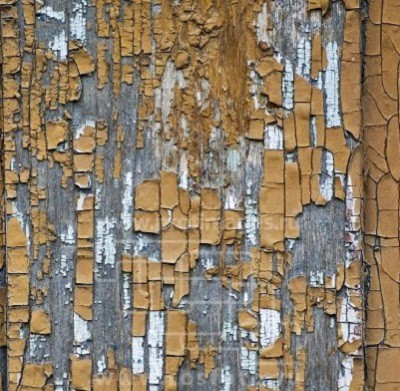
Procedure for painting a house with old paint:
- The surface of the wood is cleaned down to the base with a metal brush.
- When painting a house with acrylate paint, the house will be painted with the same paint, or with oil paint, but after pre-cleaning surfaces from old paint (see).
To prepare a wooden facade for painting you need to:
- Clean the wood from hanging pieces of old paint, remove dirt and dust with a scraper or brush.
- Rinse the facade with water, spraying the walls with a spray bottle. If mold is present, it is removed with a special solution, and to improve the adhesion of paint to wood, it can also be treated with an alkaline detergent.
- Uneven, rotten and old boards are replaced with new ones, otherwise they can spoil the whole work with their unpresentable appearance.
- Paint can be removed using scrapers, wire brushes or chemicals, but if it holds well and does not peel off, you can leave it.
- Additionally, grinding can be done if necessary.
- Next, the wooden surfaces are painted, just like on a new house.
A high-quality coating of a wooden house will preserve its beautiful appearance for a long time.